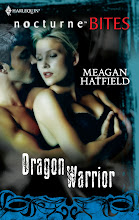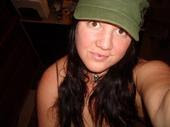I released this article in my Spring Newsletter and then SpecRom Online posted it on their website and in their newsletter. But I've been seeing a lot of discussion on this very topic on some loops I'm on and thought I'd post it here for anyone who might have missed it! Hope some of you fantasy writer's find it helpful. :-)
World Building for the Fantasy Romance
AUTHOR: Meagan Hatfield
Narnia. Middle Earth. Atlantis. Camelot.
When you hear the names of these fantasy worlds, your mind swirls with images of the inhabitants, environments and most of all, how they all fit perfectly within the story. That is successful world building. When done well, it can place your fantasy novel on the keeper shelves of readers everywhere.
Fantasy is described by Merriam-Webster’s dictionary as: "imaginative fiction featuring especially strange settings and grotesque characters.” I have to whole-heartedly disagree. To me, fantasy is more aptly described as a place where anything is possible. Unlike other genres, like say science fiction, fantasy does not have set boundaries or rules. You don’t have to abide by the scientific laws and technical or planetary details of the age. You can pretty much write anything your mind conjures.
There could be a magic spell keeping your hero and heroine apart, like in the movie LADYHAWKE. A small, peace-loving farmer set out on a life-threatening quest to destroy an evil ring, as in LORD OF THE RINGS. Or perhaps even a little boy who discovers he's a wizard and is whisked away to a special school to hone his craft. (I don’t think I have to name that book.)
Each of these fantasy examples took us to wonderfully exciting new worlds and immersed us in their respective stories. All three are different, but exceptional examples of how to successfully build a world, specific and unique to the story line/characters you're working with.
Nothing to it, right? Well, it's certainly do-able.
The first thing you want to consider is what kind of fantasy you are writing? There are four common sub genres found in fantasy romance novels, Epic being the broadest of them all. With an Epic fantasy, the world you’ve created will be at stake in a good vs. evil type situation. Both the Heroic and Sword & Sorcery sub-genres evolve from this grand, Epic beginning. In the Heroic tale, the hero sets out to save the world, thus the story becomes more about him/her than the actual act of the world being saved. (Think Frodo in the Lord of the Rings) Sword & Sorcery stories are usually set in some ancient setting, and concentrate on wizardry, swordplay, dragons, etc. (Think King Arthur, Xena, Harry Potter.) Last, the Historical fantasy will take an actual event, place or person, but add magical or supernatural elements. (Think Ladyhawke, Beauty and the Beast) Though some may argue there are more fantasy categories than I listed here, in romance we have a paranormal genre, which covers things such as werewolves, ghosts, witches, vampires and so on.
Okay, so you've chosen the specific sub-genre for your fantasy. Now it's time to create your world. The thing to remember with world building is to keep it simple. This is where it can get sticky. You don’t want to go overboard and make every element of your novel strange and overly detailed. This will only jar the reader, making it harder for them to suspend disbelief and continue reading. Instead, the goal should be to ensure the world you’ve created feels believable and comfortable.
One way to do this is to keep certain elements within your story familiar.
For example, if you have a centaur warrior as your hero, have him enjoy a cold beer while watching the two moons raise overhead. The beer keeps him real. It humanizes him in the readers mind, making him relatable. Harry Potter may be learning how to fly a broom or fight a fire-breathing dragon, but he’s doing these magical, crazy things in a school. A normal, familiar setting we are all at ease with.
Ideally, you want even your most bizarre creatures to have some human characteristics otherwise readers won't be interested in them. Perhaps there are demons from the underworld in your story. Try having them addicted to things like chocolate, tobacco or even air conditioning. Of course, the pitfall with this technique is making the world you create too similar to our own. The idea is to show the reader objects, ideas, morals, notions they can recognize and relate to, in the milieu of the new and exciting. Balance is key.
Another important factor in world building is to not only set rules, but abide by them. Stay consistent with the ideas and elements you’ve created. If the hero is a merman and the heroine a human, you have to find a logical and plausible way for them to be intimate. Maybe on certain moon cycles he can change form? Or maybe they have to be submerged? If your heroine is a witch who grows weak whenever she uses her magic, you cannot have her fight the villain in the end without showing any signs of fatigue—unless you show a reason why. As always, you don’t want to "cheat" the rules and have things "just happen". Readers are smart. You should know, you're one of them! If you cheat them, they'll put the book down. (Or throw it across the room.)
Last point…names. Use ones that fit the story time, place, feel and characters. Do not just pick some exotic, hard to pronounce name because it's different. I recommend saying the name aloud. If it trips you up, change it. Also, pay careful attention to the masculine and feminine. You don't want the readers guessing a being's gender any more than you want them stumbling over their name. And unless you are writing a time-travel fantasy, be careful not to name one character Xielnain, and another Steve.
Above all remember, however you decide to create and organize your fantasy world, make it as familiar and true to life as you can. The more ordinary it is, especially in its eccentricities, the more extraordinary and memorable it will be to the reader.
Until next time...
Wednesday, May 24, 2006
Subscribe to:
Post Comments (Atom)












No comments:
Post a Comment